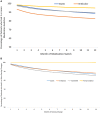Difference in Medication Adherence Between Patients Prescribed a 30-Day Versus 90-Day Supply After Acute Myocardial Infarction
- PMID: 33342227
- PMCID: PMC7955468
- DOI: 10.1161/JAHA.119.016215
Difference in Medication Adherence Between Patients Prescribed a 30-Day Versus 90-Day Supply After Acute Myocardial Infarction
Abstract
Background Evidence-based medication adherence rates after a myocardial infarction are low. We hypothesized that 90-day prescriptions are underused and may lead to higher evidence-based medication adherence compared with 30-day fills. Methods and Results We examined patients with myocardial infarction treated with percutaneous coronary intervention between 2011 and 2015 in the National Cardiovascular Data Registry. Linking to Symphony Health pharmacy data, we described the prevalence of patients filling 30-day versus 90-day prescriptions of statins, β-blockers, angiotensin-converting enzyme inhibitors/angiotensin receptor blockers, and P2Y12 inhibitors after discharge. We compared 12-month medication adherence rates by evidence-based medication class and prescription days' supply and rates of medication switches and dosing changes. Among 353 259 patients with myocardial infarction treated with percutaneous coronary intervention, 90-day evidence-based medication fill rates were low: 13.0% (statins), 12.3% (β-blockers), 14.6% (angiotensin-converting enzyme inhibitors/angiotensin receptor blockers), and 9.7% (P2Y12 inhibitors). Patients filling 90-day prescriptions were more likely older (median 69 versus 62 years) with a history of prior myocardial infarction (25.0% versus 17.9%) or percutaneous coronary intervention (30.3% versus 19.5%; P<0.01 for all) than patients filling 30-day prescriptions. The 12-month adherence rates were higher for patients who filled 90-day versus 30-day supplies: statins, 83.1% versus 75.3%; β-blockers, 72.7% versus 62.9%; angiotensin-converting enzyme inhibitors/angiotensin receptor blockers, 71.1% versus 60.9%; and P2Y12 inhibitors, 78.5% versus 66.6% (P<0.01 for all). Medication switches and dosing changes within 12 months were infrequent for patients filling 30-day prescriptions-14.7% and 0.3% for 30-day P2Y12 inhibitor fills versus 6.3% and 0.2% for 90-day fills, respectively. Conclusions Patients who filled 90-day prescriptions had higher adherence and infrequent medication changes within 1 year after discharge. Ninety-day prescription strategies should be encouraged to improve post-myocardial infarction medication adherence.
Keywords: adherence; evidence‐based medications; myocardial infarction.
Conflict of interest statement
Dr Rymer reports research grant support from Boston Scientific and Abbott Pharmaceuticals. E. Fonseca was a full‐time employee and shareholder of AstraZeneca during the study conduct. D.D. Bhandary and D. Kumar are full‐time employees of AstraZeneca. Dr Khan is a full‐time employee of AstraZeneca. Dr Wang reports research grant support from AstraZeneca, Boston Scientific, CryoLife, Daiichi Sankyo, Eli Lilly, Gilead, Novartis, and Regeneron as well as educational support from AstraZeneca, Bristol Myers Squibb, Gilead, and Merck and consulting from Pfizer and Sanofi‐Aventis.
Figures


References
-
- Smith SC Jr, Benjamin EJ, Bonow RO, Braun LT, Creager MA, Franklin BA, Gibbons RJ, Grundy SM, Hiratzka LF, Jones DW, et al. AHA/ACCF secondary prevention and risk reduction therapy for patients with coronary and other atherosclerotic vascular disease: 2011 update: a guideline from the American Heart Association and American College of Cardiology Foundation endorsed by the World Heart Federation and the Preventive Cardiovascular Nurses Association. Circulation. 2011;124:2458–2473. - PubMed
-
- Spertus JA, Kettelkamp R, Vance C, Decker C, Jones PG, Rumsfeld JS, Messenger JC, Khanal S, Peterson ED, Bach RG, et al. Prevalence, predictors, and outcomes of premature discontinuation of thienopyridine therapy after drug‐eluting stent placement: results from the PREMIER registry. Circulation. 2006;113:2803–2809. - PubMed
-
- Jackevicius CA, Li P, Tu JV. Prevalence, predictors, and outcomes of primary nonadherence after acute myocardial infarction. Circulation. 2008;117:1028–1036. - PubMed
-
- Choudhry NK, Glynn RJ, Avorn J, Lee JL, Brennan TA, Reisman L, Toscano M, Levin R, Matlin OS, Antman EM, et al. Untangling the relationship between medication adherence and post‐myocardial infarction outcomes: medication adherence and clinical outcomes. Am Heart J. 2014;167:51–58. - PubMed
Publication types
MeSH terms
Substances
LinkOut - more resources
Full Text Sources
Other Literature Sources
Medical

